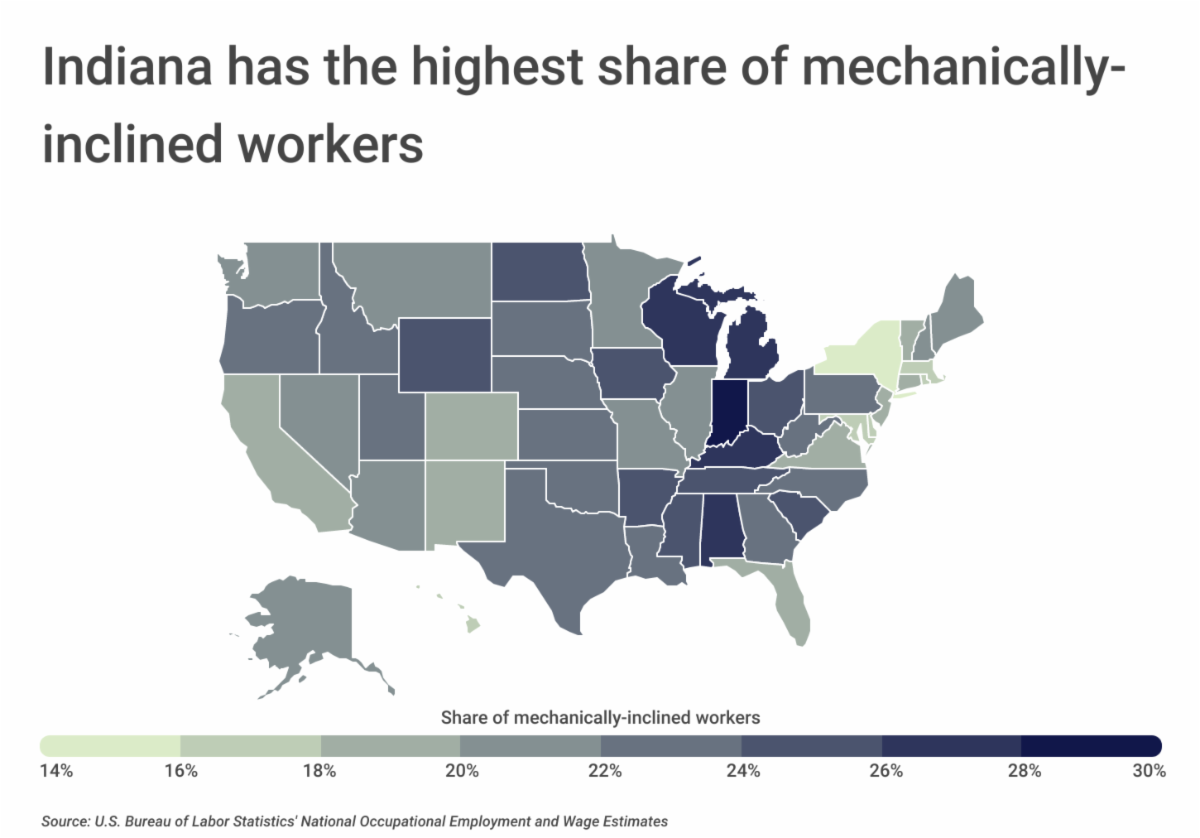Report: 22.0% of Georgia Workforce Holds Mechanically-Inclined Jobs
Wednesday, January 25th, 2023
As concerns over climate change continue to grow, there has been a sustained effort towards electrification, or the process of replacing technologies that use fossil fuels (including coal, oil, and natural gas) with technologies that use electricity for energy. States like California approved the Advanced Clear Cars II rule, which aims to phase out the purchase of new gas cars by 2035 and increase sales and utilization of zero-emissions vehicles. Meanwhile, major companies are also aiming to reduce their carbon footprints by transitioning to green technology, consuming renewable energy, and investing in carbon offsets among other solutions.
While initiatives like these are designed to help the environment, the electrification movement is putting many traditional mechanical occupations at risk. California alone projects nearly 32,000 auto mechanics jobs will be lost throughout the Golden State by 2040, in part because electric vehicles require less maintenance and repair than traditional cars.
 |
Over 600,000 Americans make a living as automotive service technicians and mechanics, but this occupation makes up just a fraction of mechanically-inclined jobs in the U.S.
Laborers and movers, or workers who manually move freight, stock, luggage or other materials, are the most common mechanically-inclined occupation. A staggering 2.7 million Americans are employed as laborers and movers in the U.S. The second most common mechanically-inclined occupation is made up of stockers and order fillers, employing nearly 2.5 million Americans. Stockers and order fillers receive, store and issue merchandise, materials, equipment, and other items from a stockroom, warehouse, or storage yard to fill shelves, racks, tables or customers’ orders. While these occupations may face other headwinds from robotics and artificial intelligence, they tend to be less affected by the transition to electrification.
 |
Although electrification will inevitably eliminate the demand for certain traditional positions, it’s also creating new opportunities, changing the landscape for mechanically-inclined occupations.
Mechanically-inclined occupations in the energy sector have the highest growth projections compared to other mechanically-inclined jobs, especially when it comes to long-term growth. Wind turbine service technician positions, with job descriptions that include installing, maintaining, and repairing wind turbines, are expected to grow the most overall. The two-year projected employment growth for wind turbine service technicians is 16.2%, with a much larger 10-year projected employment growth of 69.6%.
While the oil and gas roustabouts occupation—which has a primary responsibility of assembling or repairing oil field equipment using hand and power tools—has the second largest short-term projected growth at 13.8%, the occupation falls to sixth when it comes to long-term projections at 29.7%. Comparatively, solar photovoltaic installers, or individuals responsible for assembling, setting up, and maintaining solar rooftop systems, have a smaller short-term growth projection at 12.9%, but a significantly larger 10-year growth projection of 51.7%.
 |
The landscape for mechanically-inclined workers fluctuates regionally, with Midwest states employing the largest shares of mechanically-inclined workers, and Northeast states generally employing the fewest. Indiana employs the largest percentage at 30.1%, followed by Alabama and Kentucky at 27.3% and 27.2%, respectively. Comparatively, the states employing the fewest mechanically-inclined workers are Massachusetts, Delaware, and New York at 16.3%, 16.0%, and 15.4%, respectively. Local economies also play a major role in the employment of mechanical occupations, which may explain why the top U.S. metros with the most mechanically-inclined workers are not restricted to a single region and include cities in the Midwest, West, and South.
The data used in this analysis is from the U.S. Bureau of Labor Statistics Occupational Employment and Wage Statistics. To determine the locations with the most mechanically-inclined workers, researchers at Construction Coverage calculated the share of mechanically-inclined workers out of all workers. In the event of a tie, the location with the higher concentration of mechanically-inclined workers as compared to the national average was ranked higher. For the purpose of this analysis, mechanically-inclined workers are defined as workers in one of 269 occupations where a mechanical inclination is necessary as part of regular work activities.
Here is a summary of the data for Georgia:
-
Share of mechanically-inclined workers: 22.0%
-
Concentration of mechanically-inclined workers (compared to average): +2.3%
-
Total mechanically-inclined workers: 961,310
-
Average wage for mechanically-inclined workers: $44,945
-
Most common mechanically-inclined occupation: Laborers and Freight, Stock, and Material Movers, Hand
For reference, here are the statistics for the entire United States:
-
Share of mechanically-inclined workers: 21.5%
-
Concentration of mechanically-inclined workers (compared to average): N/A
-
Total mechanically-inclined workers: 30,334,850
-
Average wage for mechanically-inclined workers: $50,821
-
Most common mechanically-inclined occupation: Laborers and Freight, Stock, and Material Movers, Hand
For more information, a detailed methodology, and complete results, you can find the original report on Construction Coverage’s website: https://constructioncoverage.


